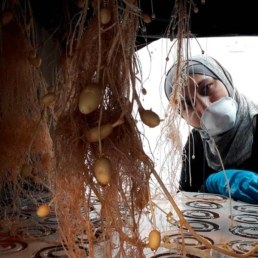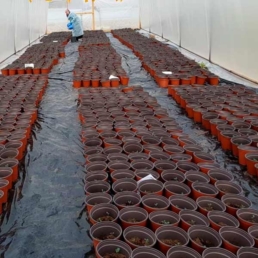Breeding mini-tubers
using the technology, that increases the number of mini-tubers up to 10 times
Greenhouses square
It is a particular greenhouse with the aerohydroponic technology
The yield of mini-tubers
It is the yield we got during the first 18 months
Potato hybrids and new varieties
We grow 157 hybrids and 5 new varieties
1500 m
Our seeds are grown at an altitude of 1500 m above sea level that reduced the risk of diseases and viruses
70 units
Aerohydroponic technology enables us to receive up to 70 mini-tubers from one micro-plant instead of 8-15 using the traditional method.
Тhe technology of mini-tubers breeding

Aerohydroponics
Aerohydroponics (also known as aeroponic) is one of the actual methods of plant cultivation that is based on oxygenation of water by passing it through the air. There are many ways to use air and water pumps or whirlpools for this purpose.
The method is one of modern varieties of hydroponics. Many people inaccurately refer to this method as “aeropony”, but it is not right. The method was developed in parallel by Israel specialists and at the University of California in Davis from the late 1970s to the mid-1980s. It supersedes the traditional methods especially in countries were commercial hydroponics has just been legally introduced. Like closed circulation system, they do not harm the environment. In large-scale polluting enterprises they are replacing the common technology, where surpluses are sent to waste. In addition, because of the dynamic circulation of water, they help to remove unwanted gases from the nutrient solution.

Cultivation in pots
A pot of sufficient volume (about the size of a bucket) with mandatory drainage holes in the bottom being filled with the fertile ground by a third, plant a potato in it and put the pot in a very well-lit place with a temperature of + 16…+ 23 degrees Celsius. Then being watered regularly, as the stems grow, and added some soil up to the top of the pot. Periodically the formed tubers being taken out with no damage to the root system.
Quality control

Growing mini-tubers is carried out with strict adherence to protective and agronomical measures excluding the possibility of infection with phytopathogens. The quality of seedlings is based on the careful examination of plants. In the flowering phase of plants leaf samplings are selected for laboratory testing for the viruses of PVX, PVS, PVM, PVY, PLRV by immune-enzyme analysis (ELISA).
In the hydroponic complexes growing mini-tubers are tested for hidden infestation with phytopathogenic viruses by the enzyme linked immunoassay (ELISA method). The existence of plants with a positive response to PVX, PVS, PVM, PVY, PLRV viruses is not allowed. According to the diagnostic results the inspection report of starting material is recorded.
Produced mini-potato tubers undergo a dormancy period of at least 3 months. They being stored in special storage equipped with a microclimate control system.
During the storage period, we carry out quality inspections. Before planting mini-tubers in the field, they are pre-heated and germinated.
How we grow our mini-tubers
1. To protect our micro-plants against viruses our seed breeding center grows them in test tubes.
2. Our micro-plants are bedded out in a greenhouse with aerohydroponic technology and climate control.
3. When our mini-tubers reach the size of 5cm wide, that is 160-190 days after bedding, they are harvested.
4. The whole yield is tested for hidden infection with phytopathogenic viruses.
5. Before bedding all seeds are warmed and sprouted.
6. After all the preparation works the seeds are sown on potatoes fields.
